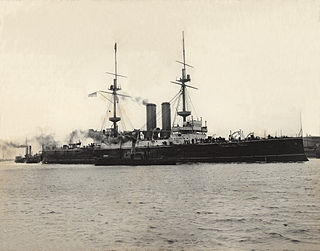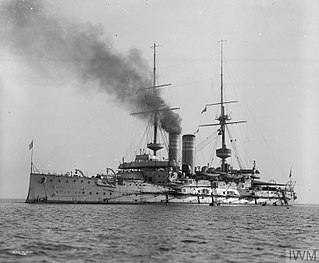
The Queen Elizabeth-class battleships were a group of five super-dreadnoughts built for the Royal Navy during the 1910s. The lead ship was named after Elizabeth I of England. These battleships were superior in firepower, protection and speed to their Royal Navy predecessors of the Iron Duke class as well as preceding German classes such as the König class. The corresponding Bayern-class ships were generally considered competitive, although the Queen Elizabeth class were 2 knots (3.7 km/h) faster and outnumbered the German class 5:2. The Queen Elizabeths are generally considered the first fast battleships in their day.

HMS Valiant was one of five Queen Elizabeth-class battleships built for the Royal Navy during the early 1910s. She participated in the Battle of Jutland during the First World War as part of the Grand Fleet. Other than that battle, and the inconclusive Action of 19 August, her service during the war generally consisted of routine patrols and training in the North Sea. She saw further action during the Second World War in the Mediterranean and Far East.

The Home Fleet was a fleet of the Royal Navy that operated from the United Kingdom's territorial waters from 1902 with intervals until 1967.

The British Mediterranean Fleet, also known as the Mediterranean Station, was a formation of the Royal Navy. The Fleet was one of the most prestigious commands in the navy for the majority of its history, defending the vital sea link between the United Kingdom and the majority of the British Empire in the Eastern Hemisphere. The first Commander-in-Chief for the Mediterranean Fleet was the appointment of General at Sea Robert Blake in September 1654. The Fleet was in existence until 1967.

The Channel Fleet and originally known as the Channel Squadron was the Royal Navy formation of warships that defended the waters of the English Channel from 1854 to 1909 and 1914 to 1915.

The 1st Battle Squadron was a naval squadron of the British Royal Navy consisting of battleships. The 1st Battle Squadron was initially part of the Royal Navy's Grand Fleet. After World War I the Grand Fleet was reverted to its original name, the Atlantic Fleet. The squadron changed composition often as ships were damaged, retired or transferred.
The 6th Battle Squadron was a squadron of the British Royal Navy consisting of Battleships serving in the Grand Fleet and existed from 1913 to 1917.
The 2nd Battle Squadron was a naval squadron of the British Royal Navy consisting of battleships. The 2nd Battle Squadron was initially part of the Royal Navy's Grand Fleet. After World War I the Grand Fleet was reverted to its original name, the Atlantic Fleet. The squadron changed composition often as ships were damaged, retired or transferred.

The 3rd Battle Squadron was a naval squadron of the British Royal Navy consisting of battleships and other vessels, active from at least 1914 to 1945. The 3rd Battle Squadron was initially part of the Royal Navy's Home Fleet. During the First World War, the Home Fleet was renamed the Grand Fleet. During the Second World War, the squadron covered Atlantic convoys.

The 4th Battle Squadron was a squadron of the British Royal Navy consisting of battleships. The 4th Battle Squadron was initially part of the Royal Navy's Home Fleet (1912-14) and then the Grand Fleet after the outbreak of the First World War. The squadron changed composition often as ships were damaged, retired or transferred.

The 3rd Battlecruiser Squadron was a short-lived Royal Navy squadron of battlecruisers that saw service as part of the Grand Fleet during the First World War.

The First Battlecruiser Squadron was a Royal Navy squadron of battlecruisers that saw service as part of the Grand Fleet during the First World War. It was created in 1909 as the First Cruiser Squadron and was renamed in 1913 to First Battle Cruiser Squadron. It participated in the battles of Heligoland Bight, Dogger Bank and the Battle of Jutland. After the end of the war it became the sole Battlecruiser Squadron.

The 2nd Battlecruiser Squadron was a Royal Navy squadron of battlecruisers that saw service as part of the Grand Fleet during the First World War.

The Battle Cruiser Fleet, (BCF), later known as Battle Cruiser Force, a naval formation of fast battlecruisers of the Royal Navy, operated from 1915 to 1919.

The Battlecruiser Squadron was a Royal Navy squadron of battlecruisers that saw service from 1919 to the early part of the Second World War.

The First Cruiser Squadron was a Royal Navy squadron of cruisers that saw service as part of the Grand Fleet during the World War I then later as part of the Mediterranean during the Interwar period and World War II it first established in 1904 and existed until 1952.

The 7th Battle Squadron was a squadron of the British Royal Navy assembled prior to World War One it was assigned to the Third Fleet and consisted of pre-dreadnought type battleships the oldest ships in fleet it existed from 1912 to 1914.

The 8th Battle Squadron was a squadron of the British Royal Navy assembled prior to the beginning of World War One; it was later assigned to the Third Fleet. The squadron consisted of pre-dreadnought type battleships. It existed from 1912 to 1914.

The Eastern Mediterranean Squadron and later known as the British Aegean Squadron was a sub- command of the Mediterranean Fleet based at Mudros from 1914 to 1916 then alternating between Mudros and Salonika from 1917 to 1919.











